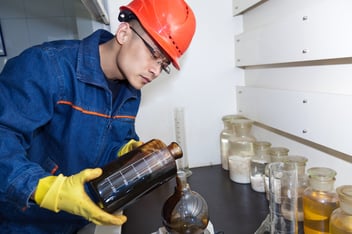How Does Coagulation in Water Treatment Work?
Coagulation is one of the most critical steps in modern water treatment processes.
This fundamental technique transforms murky, contaminated water into clear, safe water by removing suspended particles, colloids, dissolved organic matter, and various contaminants.
While they might not have understood it as we do today, it's a process that even ancient peoples recognized and implemented. As the EPA noted in a 2000 summary, the ancient Egyptians used alum as early as 1500 B.C. for the purpose of water clarification. 
Clearly, no pun intended, they were onto something. Now, thousands of years later, we've made many advancements in the field of water treatment: if you're a water treatment professional, it's important to know all of the options available to you.
For water treatment professionals seeking to optimize their operations, understanding coagulation principles and selecting the right coagulants can:
- Improve treatment efficiency
- Reduce costs
- Ensure regulatory compliance
What is Coagulation in Water Treatment?
Coagulation is a physicochemical process where chemical agents (coagulants) are added to water to destabilize suspended and colloidal particles. In natural water sources, many particles carry a negative electrical charge, causing them to repel each other and remain suspended. Coagulants neutralize these charges, allowing particles to come together to form larger aggregates called "flocs" which can then be more easily removed through subsequent treatment processes like sedimentation and filtration.
This crucial step addresses several key water quality parameters:
- Turbidity reduction
- Color removal
- Pathogen elimination
- Reduction of dissolved organic matter
- Removal of heavy metals and other contaminants
Industries Relying on Coagulation Processes
So which industries rely on coagulation to get things done?
Various sectors depend on effective coagulation as part of their water treatment protocols, including:
Municipal Water Treatment
Public water utilities represent the largest users of coagulation technology. These facilities process millions of gallons daily, converting surface water from rivers, lakes, and reservoirs into potable drinking water. Coagulation helps these plants meet stringent drinking water standards while handling seasonal variations in source water quality.
Wastewater Treatment
Both municipal and industrial wastewater facilities employ coagulation to remove suspended solids, phosphorus, and other pollutants before discharging treated water back to the environment. This application is crucial for environmental protection and regulatory compliance.
Food and Beverage Industry
Companies producing beverages, dairy products, and processed foods require ultra-pure water. Coagulation helps remove particulates and organic compounds that could affect taste, appearance, or safety of the final products.
Pulp and Paper Manufacturing
This sector generates wastewater with high concentrations of suspended solids and dissolved organic compounds. Coagulation efficiently removes these contaminants, allowing water reuse and reducing environmental impact.
Mining Operations
Mine drainage water often contains heavy metals and fine mineral particles. Coagulation precipitates these contaminants, facilitating their removal and allowing for safer discharge or recycling of process water.
Textile Industry
Textile manufacturing produces wastewater with dyes, fibers, and various chemicals. Coagulation effectively removes color and suspended materials from these complex waste streams.
Pharmaceutical Manufacturing
Pharmaceutical companies rely on highly purified water. Coagulation serves as an important pretreatment step in producing water that meets stringent quality requirements.
what Types of Coagulants are used in Modern Water Treatment?
The coagulant market offers diverse options, each with specific advantages for different applications. Three major categories dominate the field:
Synthetic (Inorganic) Coagulants
These traditional, widely-used coagulants include:
Aluminum-Based Coagulants
- Aluminum sulfate (alum): The most commonly used coagulant worldwide
- Polyaluminum chloride (PAC): Effective across a broader pH range than alum
- Aluminum chlorohydrate (ACH): High aluminum content, efficient at lower doses
Iron-Based Coagulants
- Ferric chloride: Highly effective for phosphorus removal and odor control
- Ferric sulfate: Strong performance in cold water conditions
- Ferrous sulfate: Often used in combination treatments
Natural Coagulants
Growing environmental awareness has renewed interest in plant-based and other natural coagulants, like the chitosan-based products Dober specializes in:
Plant-Derived Coagulants
- Moringa oleifera seed extract: Effective protein-based coagulant used in developing regions
- Cactus extract: Contains natural polymers that demonstrate coagulation properties
- Tannins: Plant-derived compounds with coagulation capabilities
Animal-Derived Coagulants
- Chitosan: Derived from crustacean shells, biodegradable and effective at removing metals
- Microbial biopolymers: Produced by bacteria, offering sustainable alternatives
Natural coagulants appeal to environmentally conscious operations and often produce biodegradable sludge. Their application has expanded in regions seeking sustainable water treatment solutions.
Hybrid and Polymer Coagulants
These advanced coagulants combine the benefits of multiple approaches:
Synthetic Organic Polymers
- Polyacrylamides: High molecular weight flocculants that enhance conventional coagulants
- Polyamines: Cationic polymers effective as primary coagulants or coagulant aids
- Polydiallyldimethylammonium chloride (polyDADMAC): Versatile cationic polymer
Hybrid Coagulants
- Composite coagulants combining inorganic salts with polymers
- Pre-hydrolyzed metal salts with modified structures
- Dual-coagulant systems optimized for specific water qualities
For those interested in a deeper breakdown, check out our article on the differences between natural and synthetic water treatment products.
What are the Benefits of Coagulation in Water Treatment Operations?
Implementing effective coagulation processes delivers numerous advantages to water treatment facilities:
Operational Benefits
- Increased treatment capacity: Efficient coagulation allows facilities to process more water through existing infrastructure
- Reduced chemical consumption: Optimized coagulation can decrease overall chemical usage
- Lower energy requirements: Effective particle removal reduces the burden on downstream processes
- Extended filter runs: Proper coagulation protects filters from rapid clogging
- Reduced sludge production: Advanced coagulants can minimize the volume of waste solids
Water Quality Improvements
- Enhanced pathogen removal: Coagulation significantly reduces microbial contaminants
- Disinfection byproduct precursor reduction: Removing organic matter prevents formation of harmful byproducts
- Consistent finished water quality: Stable coagulation buffers against source water variations
- Improved aesthetic quality: Clear, colorless water with no unpleasant taste or odor
Regulatory and Economic Advantages
- Regulatory compliance: Meets increasingly stringent water quality standards
- Cost-effective contaminant removal: More economical than advanced treatments for many contaminants
- Reduced lifecycle costs: Proper coagulation extends equipment life and reduces maintenance
- Sustainability improvements: Modern coagulation approaches support water reuse and conservation goals
COAGULATION Conclusion
Coagulation remains an indispensable process in modern water treatment, evolving with new technologies and environmental priorities. Water treatment professionals across diverse industries benefit from understanding the range of available coagulants and optimizing their application based on specific water quality challenges.
Whether managing a municipal water plant, industrial facility, or specialized treatment operation, investing in effective coagulation technology pays dividends through improved water quality, operational efficiency, and regulatory compliance. As water quality demands increase and environmental concerns grow, the importance of sophisticated coagulation processes will only continue to expand in the water treatment landscape.
If you're interested in learning more about what Dober has to offer with respect to coagulants, download our product catalog to learn more.




